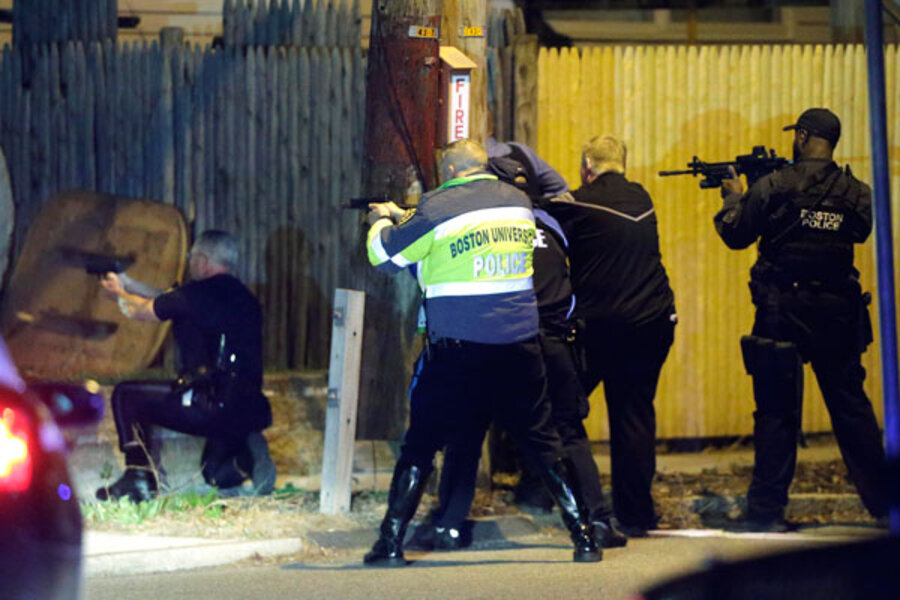National Geographic presents 'Boston Bombers' docudrama
Loading...
It was an event that shut down a city and held the world’s attention. A cheerful spring day at the finish of the 2013 Boston Marathon was interrupted by two bombings that killed three people and wounded more than 250. A search for the individuals responsible unfolded over the following five days with unbelievable horror, drama, and unexpected turns.
"Inside the Hunt for the Boston Bombers" is the National Geographic Channel’s gripping docudrama that re-creates the massive manhunt for the suspects. Based on eyewitness accounts, “Inside the Hunt,” airing April 13 at 9 p.m., relies on the narratives of law enforcement officials, survivors, and ordinary citizens swept up in the tide of events to retell the story of April 15, 2013, and the days that immediately followed.
There are countless threads to follow in the Boston bombings, but National Geographic chose the compelling angle of cooperation. “Inside the Hunt” offers a reassuring message for Americans still swimming in the wake of 9/11, two wars abroad, and the constant thrum of uncertainty about global and personal safety: We can face and stop evil.
It is more of a feel-good interpretation of the coordinated efforts in the bombings aftermath than the analysis offered by a recent Harvard study, indicating that recklessness on the part of anxious, self-deploying law enforcement officers was dangerously present during the whole affair, the Monitor reported.
Beyond presenting a perspective that puts law enforcement in a positive light, with no mention of media efforts to keep a terrified public "sheltering in place" informed other than its gaffes, there is no overarching narrator or analysis for “Inside the Hunt.” Alleged bombers Tamerlan and Dzhokhar Tsarnaev are kept as nondescript, menacing targets. But at the Boston screening at the Wilbur Theater on April 9, several speakers provided context for the bombings' lasting impact and the city’s swift response to care for the wounded and hunt for the perpetrators.
Dr. Leonard Marcus at Harvard’s School of Public Health, who has played a leading national and international role in terrorism preparedness and emergency response, says he and his colleagues tried to decipher what had happened during those sleepless nights in Boston when differing law enforcement teams formed into a seamless body as they identified, tracked, and apprehended the suspects. He remarked on their seeming ability to set aside ego, competition, and blame to unify their efforts.
“When we really bore down on it, we realized it followed the same principles that govern swarm intelligence,” Dr. Marcus told the Boston audience made up of first responders, law enforcement, city officials, and survivors.
Swarm intelligence is the scientific term that describes how animal communities, without a leader, can act collectively with remarkable agility – think of a flock of birds swerving through the sky or ants carving underground tunnels – by giving and heeding each others' simple cues.
The same principles were at play, he says, in Boston’s alphabet soup of law enforcement – FBI, the police department, the mayor’s office, the governor’s office, and others – as they steered through an avalanche of evidence, tips, and false leads under tremendous pressure.
“Boston is one big village,” said Marcus. “It has a tradition of preparedness, a tradition of caring for one another.”
It’s a sentiment that Massachusetts Gov. Deval Patrick echoes in the film, “There is power in turning to each other in an event like that, instead of turning on each other,” he said.
The docudrama relies on central players and actors to recreate what happened at the finish line that day in an urgent but tasteful way. While the manhunt is the main focus and sets the pace of the film, voices of survivors also guide viewers through their shock, emotions, and gradual steps toward recovery.
“The survivor’s marathon began when the bombs went off,” said Dr. David Crandall, a medical director for the amputee program at Boston’s Spaulding Rehabilitation Hospital, at the Boston screening. And for many that marathon of recovery continues, healing both seen and unseen wounds.
Michele Mahoney, who offers her survivor’s tale in “Inside the Hunt,” is not planning on being at the finish line of the 2014 Boston Marathon. “I had never been to the finish line before. I had just gone to cheer on my best friend and she's not running again this year,” she told the Monitor. Mahoney says a number of the survivors felt that they should go to this year’s race, to show how far they had progressed and to help reclaim the joy of the event. But Mahoney plans to spend the day quietly with family, friends, and the boyfriend she had just began dating when her life tilted into chaos at the finish line last year.
"The bombing was one second of humanity at its worst,” survivor Jarrod Clowery told the audience at the screening. “Since then there have been millions of seconds of humanity at its best.”
“Inside the Hunt for the Boston Bombers” premieres April 13 at 9 p.m., with an encore airing April 16, on the National Geographic Channel. Check natgeotv.com for future airings or visit its interactive page at http://bit.ly/NatGeoBoston.








